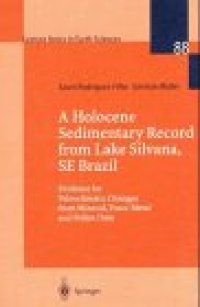
Ebook: A Holocene Sedimentary Record from Lake Silvana, SE Brazil: Evidence for Paleoclimatic Changes from Mineral, Trace-Metal and Pollen Data
- Tags: Geology, Meteorology/Climatology, Oceanography, Hydrogeology
- Series: Lecture Notes in Earth Sciences 88
- Year: 1999
- Publisher: Springer-Verlag Berlin Heidelberg
- Edition: 1
- Language: English
- pdf
Mineralogical-sedimentological and geochemical investigations in combination with pollen data of a 12.7-m-long dated sediment core from Lake Silvana, SE Brazil, permit the reconstruction of the climatic history over the past 10,000 years. The lowermost section (I) reflects a coarse paleosol-type sediment with abundant plant debris and rootlets; pollen indicates grassland vegetation. Section II represents fine-grained lake sediments; pollen indicates a savanna-like vegetation. Section III represents a pollen-free, coarse-grained allogenic sediment deposited under high transportation energy (increased precipitation). Section IV, a greenish sequence with increasing C content towards the top, has a pollen spectrum of present-day vegetation (semideciduous forest). The different sediment sections show a connection with erosional phases in the catchment of the lake, based on mineralogy and geochemistry, which are a response to climate development.
Mineralogical-sedimentological and geochemical investigations in combination with pollen data of a 12.7-m-long dated sediment core from Lake Silvana, SE Brazil, permit the reconstruction of the climatic history over the past 10,000 years. The lowermost section (I) reflects a coarse paleosol-type sediment with abundant plant debris and rootlets; pollen indicates grassland vegetation. Section II represents fine-grained lake sediments; pollen indicates a savanna-like vegetation. Section III represents a pollen-free, coarse-grained allogenic sediment deposited under high transportation energy (increased precipitation). Section IV, a greenish sequence with increasing C content towards the top, has a pollen spectrum of present-day vegetation (semideciduous forest). The different sediment sections show a connection with erosional phases in the catchment of the lake, based on mineralogy and geochemistry, which are a response to climate development.